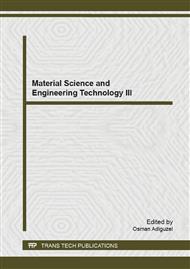[1]
I. Frank P., D. David P., B. Theodore L. and L. Adrienne S., Fundamentals of heat and mass transfer, sixth ed., John Wiley, United States, (2007).
Google Scholar
[2]
A. Adekunle O., D. Jaco, M. Josua P., Effects of the thick walled pipes with convective boundaries on laminar flow heat transfer, Applied Energy 130 (2014) 838–845.
DOI: 10.1016/j.apenergy.2014.01.072
Google Scholar
[3]
A. Ali, D. Selcuk, B. Sefik, Unsteady conjugated heat transfer in thick walled pipes involving two-dimensional wall and axial fluid conduction with uniform heat flux boundary condition, International Journal of Heat and Mass Transfer 53 (2010).
DOI: 10.1016/j.ijheatmasstransfer.2010.07.059
Google Scholar
[4]
L. Tao, W. Kui-sheng, Numerical analysis of the heat transfer associated with freezing /solidifying phase changes for a pipeline filled with crude oil in soil saturated with water during pipeline shutdown in winter, Journal of Petroleum Science and Engineering 62 (2008).
DOI: 10.1016/j.petrol.2008.07.004
Google Scholar
[5]
R. Banki, H. Hoteit, A. Firoozabadi, Mathematical formulation and numerical modeling of wax deposition in pipelines from enthalpy–porosity approach and irreversible thermodynamics, International Journal of Heat and Mass Transfer 51 (2007).
DOI: 10.1016/j.ijheatmasstransfer.2007.11.012
Google Scholar
[6]
H. K. Verstreeg and W. Malalasekera, An Introduction to Computational Fluid Dynamics: The Finite Volume Method, second ed., Longman, England, (2007).
Google Scholar
[7]
P. Suhas V., Numerical heat transfer and fluid flow, Hemisphere, United States, (1980).
Google Scholar
[8]
K. Jaydeep M., T. Christopher T., A. Ali, S. Tony L., Value of information-based experimental design: Application toprocess damping in milling, Precision Engineering 38 (2014) 799–808.
DOI: 10.1016/j.precisioneng.2014.04.008
Google Scholar
[9]
R. Wanwisa et al. Development of CFD Simulator for Multi-phase Flow System. 1/2014 Chemical Technology Seminar. Bangkok, Thailand, (2014).
Google Scholar
[10]
G. Zhang, G. Liu, Study on the wax deposition of waxy crude in pipelines and its application, Journal of Petroleum Science and Engineering 70 (2010) 1–9.
DOI: 10.1016/j.petrol.2008.11.003
Google Scholar
[11]
K. Lateef, I. Tajudeen M., O. James E., Isobaric specific heat capacity of natural gas as a function of specific gravity, pressure and temperature. Journal of Natural Gas Science and Engineering, 19 (2014) 74-83.
DOI: 10.1016/j.jngse.2014.04.011
Google Scholar


